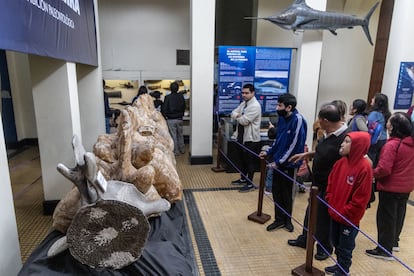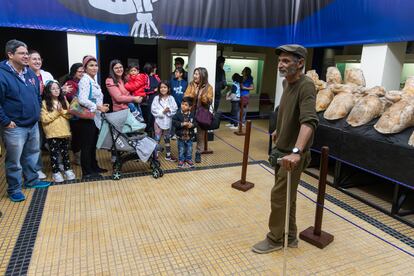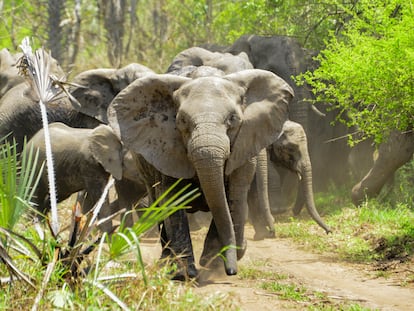Mario Urbina: The man who discovered the heaviest animal that ever existed never studied paleontology
The Peruvian fossil hunter found the vertebrae of ‘Perucetus colossus,’ the most recent enigma of science

For a month now, Peruvians and foreigners have flocked to the Natural History Museum in Lima to see twelve vertebrae, four ribs, and a pelvis. But above all to shake hands with a bony man in baggy pants: Mario Urbina Schmitt, the man who discovered Perucetus colossus, a prehistoric cetacean that swam in the depths of the Peruvian coast 39 million years ago. A single vertebra of this creature weighs more than 100 kilos, and it is estimated that on average it would have reached 197 tons. Almost fifty tons more than a blue whale, which before this discovery held the title for the heaviest animal in history.
This Saturday morning in August, Urbina is being besieged by a dozen families who are fighting for a photo with him, in the room that houses the incomplete skeleton. From the ceiling, a gigantic, colorful poster announces what could well be a circus marvel. Children and adults are amazed by the silhouette of Perucetus colossus: its huge and plump body like that of a manatee and a head as small as a pin. The representation of the head, in reality, is a mystery to be solved, since no trace has yet been found in the Ocucaje desert, the great fossil cemetery in Ica, south of Lima.
One of the many women thanks Urbina for having registered the marine beast with a patriotic name, thus making him an “ambassador of Peru,” and then asks him when he will continue the search for the monster. Urbina, who in recent weeks has displayed his eccentricity to respond to the press, absolves his doubt with brutal honesty: “Before going back to the desert I want to gain weight. I look like a skeleton,” he says, leaning on his cane.

Mario Urbina has dedicated at least 40 of his 61 years to unearthing the remains of fantastic beasts in inaccessible areas, exposed to radiation, and in the midst of hurricane force winds. And you can see it. His face and arms have taken on a permanent tan that contrasts with his torso. His eyes, which were originally dark brown, have lightened. The effect, he says, is that his vision is getting worse and worse. From chewing so much sand in the desert, his teeth became infected and now all his teeth are false. He has used a cane for four years, because one day he began to limp on his right leg. He thinks it’s from a misapplied injection that could have affected his sciatic nerve. But Urbina does not want certainties. He has resisted setting foot in a hospital for fear of being advised to withdraw from expeditions. His life plan remains firm: to die on a fossil.
Added to his ills is a considerable weight loss that places him well below 60 kilos (132 pounds) and for which many of his acquaintances have asked him with concern if he has a disease. He says that he has spent the last few months, before becoming a celebrity, eating fried plantains from two failed trips to the Ocucaje desert where he did not find any more bones of the Perucetus colossus with his team. And not finding anything means losing money and running out of budget. That’s why he often says, half jokingly, half seriously, that this monster has ruined him.
Ten years have passed since Mario Urbina accidentally discovered a part of the Perucetus colossus fossil, on a promontory that he had passed many times. It took him four years to convince the scientific community that it was bone and not rock; and six years to excavate meters and meters of solid rock — first by hand with a pick, hammer, and chisel, and then with machinery — to obtain enough bone evidence, calculate its dimensions, carry out a myriad of studies and apply to Nature magazine that published the research on August 2 and, with this, certified its birth (Urbina shares co-authorship with fifteen scientists). Everything was done with foreign financing. Urbina is against asking the Peruvian State for money, because he considers that paleontology has a lot of risk, and he would not want to justify missions that last several months and may result in nothing.
But Mario Urbina is not only the man who has discovered the heaviest animal that has inhabited the Earth. His uniqueness is not reduced to being a researcher who refuses to extend his hand to the state. He is one of the most respected paleontologists in the world, but he has never taken a single paleontology course. What’s more, he didn’t finish school. He only finished up the second year of high school. “Previously, the Ministry of Culture pursued me like an animal, and they wanted to put me in jail because for years I have unearthed fossils without their permission. They have never let me dig because I didn’t finish school. They have always underestimated me,” he says in his vertebrate laboratory.

It’s Monday, and today the Natural History Museum of the Universidad Nacional Mayor de San Marcos is not open to the public. Therefore, your most illustrious host will be able to devote all his attention to us. Mario Urbina lights the first of the ten cigarettes he will smoke this afternoon. “I can run out of water in the desert, but not cigarettes,” he used to say. On a wooden table you can see the plaster of an ancient crocodile, the head of a sea lion, and a radio covered in dust. A few steps away, dozens of used glue sticks and a faded newspaper clipping on a wooden piece of furniture where Urbina is referred to as the “Indiana Jones of the Peruvian desert.”
In addition to Perucetus colossus, this fossil hunter who began unearthing human skeletons as a teenager in a colonial cemetery located in Chaclacayo, east of Lima, has other milestones to his credit: in 2001 he discovered the fossil of a with 300,000-year-old South American horse; the following year he unearthed a penguin skeleton from six million years ago that now bears his last name: Spheniscus urbinai; and in 2007 he excavated a giant sloth from 12 thousand years ago, which was also baptized with his last name: Megatherium urbinai. But one of his most famous finds happened in 2018 when he found the first footed whale in South America dating back 42 million years. Last year he was not far behind: he presented the remains of the Ocucaje basilosaurus, an ancestor of a whale dating back 36 million years. In most of those excavations, Eusebio Díaz, one of his workers, made payments to the land with liquor and tobacco. His team is essential, and that is why he recognizes their work every time he is in front of an audience.
“I want to blow up the area to find the head and teeth of Perucetus. It is the only way to know what it ate and what its lifestyle was. And I’m not going to wait another six years to find out. I only ask the authorities that they let me work in peace and that they declare the zone [legally] intangible to ward off land traffickers,” Urbina asserts, tapping with his cane as the afternoon fades away. Tomorrow the visitors will return to the museum, and this emaciated man will be on time, waiting for them in front of the vertebrae of the Perucetus colossus. “For me, it is the opportunity to touch people and thank them. No one had ever come to thank me before,” says Urbina and throws the last cigarette butt on the ground. And with that, he heads off to the bakery. It’s lunchtime.
Sign up for our weekly newsletter to get more English-language news coverage from EL PAÍS USA Edition
Tu suscripción se está usando en otro dispositivo
¿Quieres añadir otro usuario a tu suscripción?
Si continúas leyendo en este dispositivo, no se podrá leer en el otro.
FlechaTu suscripción se está usando en otro dispositivo y solo puedes acceder a EL PAÍS desde un dispositivo a la vez.
Si quieres compartir tu cuenta, cambia tu suscripción a la modalidad Premium, así podrás añadir otro usuario. Cada uno accederá con su propia cuenta de email, lo que os permitirá personalizar vuestra experiencia en EL PAÍS.
¿Tienes una suscripción de empresa? Accede aquí para contratar más cuentas.
En el caso de no saber quién está usando tu cuenta, te recomendamos cambiar tu contraseña aquí.
Si decides continuar compartiendo tu cuenta, este mensaje se mostrará en tu dispositivo y en el de la otra persona que está usando tu cuenta de forma indefinida, afectando a tu experiencia de lectura. Puedes consultar aquí los términos y condiciones de la suscripción digital.
More information
Archived In
Últimas noticias
Most viewed
- Sinaloa Cartel war is taking its toll on Los Chapitos
- Oona Chaplin: ‘I told James Cameron that I was living in a treehouse and starting a permaculture project with a friend’
- Reinhard Genzel, Nobel laureate in physics: ‘One-minute videos will never give you the truth’
- Why the price of coffee has skyrocketed: from Brazilian plantations to specialty coffee houses
- Silver prices are going crazy: This is what’s fueling the rally










































